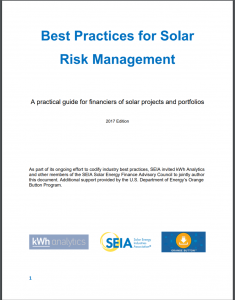Full Title: Best Practices for Solar Risk Management: A practical guide for financiers of solar projects and portfolios
Author(s):
Publisher(s): Solar Energy Industries Association
Publication Date: September 1, 2017
Full Text: Download Resource
Description (excerpt):
Tax equity and debt investment in solar energy projects require complex due diligence and oversight by investors. Fortunately, the industry has matured greatly over the past decade, and industry stakeholders have developed highly effective risk management techniques to improve the quality of project cash flows and reduce the risk of technological and credit-related risk factors.
This analysis was written for bank risk managers, credit officers, and senior business leaders who recognize a wide range of potential risk factors pertaining to solar investments and seek a systematic distillation of the industry’s best practices. Since the risk management function begins at origination, the audience also includes those within the sales or origination function at banks or within project finance groups at solar companies. This report assumes that a reader has a basic competence in project finance and tax equity structures. This guide is designed to provide an authoritative perspective on solar risk management, as this document reflects experiences and learnings drawn from investors representing more than 50% of the U.S. market.
In this report, we contrast “risk management,” which is the responsibility of a financial investor, to “asset management,” which is typically the domain of a solar company to maintain the physical asset and the associated contractual arrangements. For our purposes, asset management also includes the administration of an operations and maintenance program. Risk management covers the investor’s responsibility to satisfy the internal business and compliance requirements of senior business leaders, credit committees, internal and external auditors, and regulators. The responsibility of the risk manager is to identify items that may lead to the financial deterioration of an investment, and proactively work to resolve these situations. Although much of the data is derived by the asset manager, a key role of the risk manager is to “trust, but verify” the results being presented to them.
While solar investments are sometimes called “passive investments” due to the nature of the structured vehicles, this is in practice a misnomer: Nearly every major investor in the renewable energy markets have staff dedicated to risk management. Fortunately, there are a number of practices and platforms in the market for financial investors to monitor, measure, and manage their risk. These best practices are common between various segments of the solar industry, ranging from distributed residential portfolios to utility-scale assets, and are the topic of this report.
